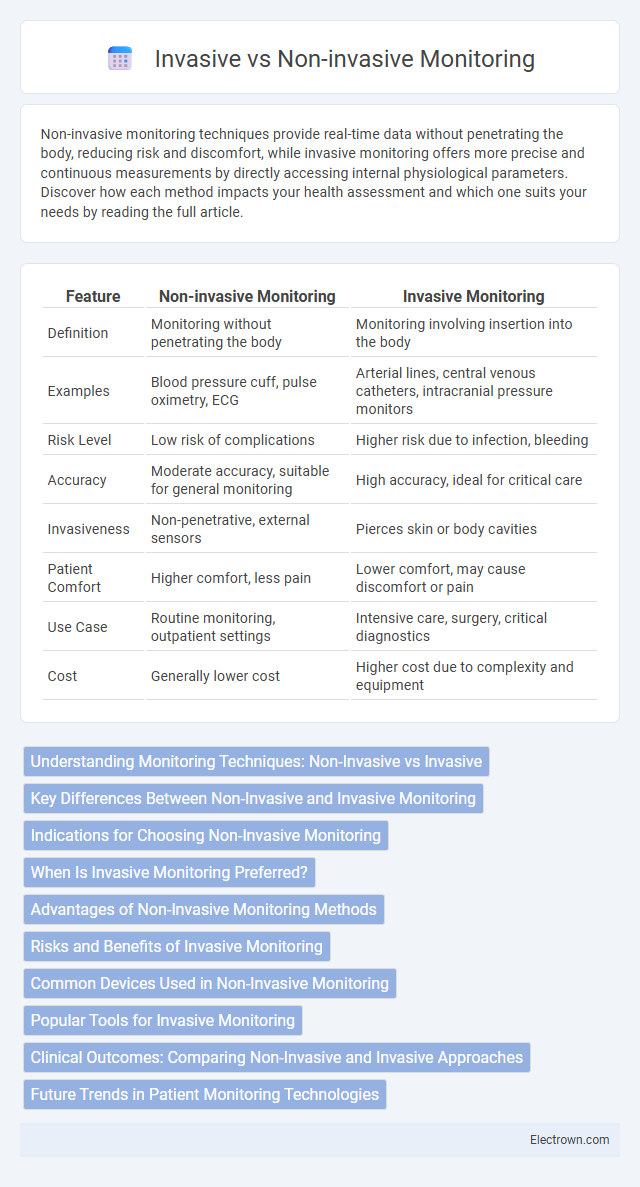Non-invasive monitoring techniques provide real-time data without penetrating the body, reducing risk and discomfort, while invasive monitoring offers more precise and continuous measurements by directly accessing internal physiological parameters. Discover how each method impacts your health assessment and which one suits your needs by reading the full article.
Table of Comparison
| Feature | Non-invasive Monitoring | Invasive Monitoring |
|---|---|---|
| Definition | Monitoring without penetrating the body | Monitoring involving insertion into the body |
| Examples | Blood pressure cuff, pulse oximetry, ECG | Arterial lines, central venous catheters, intracranial pressure monitors |
| Risk Level | Low risk of complications | Higher risk due to infection, bleeding |
| Accuracy | Moderate accuracy, suitable for general monitoring | High accuracy, ideal for critical care |
| Invasiveness | Non-penetrative, external sensors | Pierces skin or body cavities |
| Patient Comfort | Higher comfort, less pain | Lower comfort, may cause discomfort or pain |
| Use Case | Routine monitoring, outpatient settings | Intensive care, surgery, critical diagnostics |
| Cost | Generally lower cost | Higher cost due to complexity and equipment |
Understanding Monitoring Techniques: Non-Invasive vs Invasive
Non-invasive monitoring techniques utilize external sensors to measure physiological parameters such as heart rate, blood pressure, and oxygen saturation without penetrating the skin, reducing patient risk and discomfort. Invasive monitoring involves the insertion of catheters or probes into the body to obtain direct measurements of blood gases, cardiac output, or intracranial pressure, offering higher accuracy and continuous real-time data. Selecting between non-invasive and invasive methods hinges on clinical requirements, patient condition, and the need for precision versus safety.
Key Differences Between Non-Invasive and Invasive Monitoring
Non-invasive monitoring measures physiological parameters without penetrating the skin, using tools like pulse oximeters and blood pressure cuffs, offering minimal risk and quick setup. Invasive monitoring requires insertion of devices such as arterial lines or central venous catheters, providing continuous, highly accurate data essential for critically ill patients. Understanding these key differences helps ensure your choice aligns with patient safety and the required level of monitoring accuracy.
Indications for Choosing Non-Invasive Monitoring
Non-invasive monitoring is indicated for patients requiring continuous or repeated assessment without the risks associated with invasive procedures, such as those with stable cardiovascular or respiratory conditions. It is preferred in scenarios where patient comfort and reduced infection risk are essential, including outpatient settings and neonatal care. This approach is also suitable for early detection of physiological changes, enabling timely intervention while minimizing complications.
When Is Invasive Monitoring Preferred?
Invasive monitoring is preferred in critical care settings where real-time, accurate hemodynamic data such as arterial blood pressure, central venous pressure, and cardiac output are essential for patient management. It is particularly necessary during major surgeries, severe trauma, and in patients with unstable cardiovascular conditions requiring continuous monitoring. This method provides precise measurements that non-invasive techniques cannot reliably deliver in high-risk scenarios.
Advantages of Non-Invasive Monitoring Methods
Non-invasive monitoring methods offer significant advantages including reduced risk of infection, greater patient comfort, and lower overall costs compared to invasive techniques. These methods facilitate continuous monitoring without the need for surgical procedures, minimizing trauma and allowing for quick, repeatable assessments. Your healthcare experience benefits from increased safety and faster recovery times using non-invasive technologies.
Risks and Benefits of Invasive Monitoring
Invasive monitoring offers precise and continuous data collection critical for managing critically ill patients, particularly in intensive care units and during complex surgeries. Risks include infection, bleeding, thrombosis, and arterial damage due to catheter insertion, requiring careful consideration of patient condition and monitoring necessity. Despite these risks, the benefits of accurate hemodynamic assessment and timely intervention often outweigh potential complications in high-acuity clinical scenarios.
Common Devices Used in Non-Invasive Monitoring
Common devices used in non-invasive monitoring include pulse oximeters, blood pressure cuffs, and wearable ECG monitors that provide continuous data without penetrating the skin. These tools leverage optical sensors, oscillometric technology, and surface electrodes to track vital signs such as oxygen saturation, heart rate, and blood pressure. Your ability to monitor health parameters comfortably and safely is enhanced through these non-invasive technologies, offering reliable real-time insights without the risks associated with invasive methods.
Popular Tools for Invasive Monitoring
Popular tools for invasive monitoring include arterial catheters, central venous catheters, and pulmonary artery catheters, which provide continuous and accurate measurements of blood pressure, central venous pressure, and cardiac output. These devices are essential in critical care settings for real-time data that guide therapeutic decisions. Your healthcare team relies on these invasive tools to closely monitor hemodynamic status and optimize patient management.
Clinical Outcomes: Comparing Non-Invasive and Invasive Approaches
Non-invasive monitoring methods, such as pulse oximetry and wearable sensors, offer improved patient comfort and reduced infection risk while maintaining accurate clinical outcomes in many scenarios. Invasive approaches like arterial catheterization provide continuous, high-fidelity data crucial for critically ill patients, but carry increased risks including bleeding and infection. Your clinical decisions should weigh the benefits of precision against potential complications to optimize patient safety and treatment effectiveness.
Future Trends in Patient Monitoring Technologies
Emerging patient monitoring technologies prioritize non-invasive methods utilizing advanced sensors, wearable devices, and artificial intelligence to enhance real-time data accuracy and patient comfort. Invasive techniques are evolving with miniaturized, implantable devices that provide continuous, precise monitoring of critical parameters such as blood glucose, intracranial pressure, and cardiac function. Future trends emphasize integration of telemedicine, predictive analytics, and cloud-based platforms to enable proactive healthcare management and reduce hospital readmissions.
Non-invasive vs Invasive Monitoring Infographic

 electrown.com
electrown.com